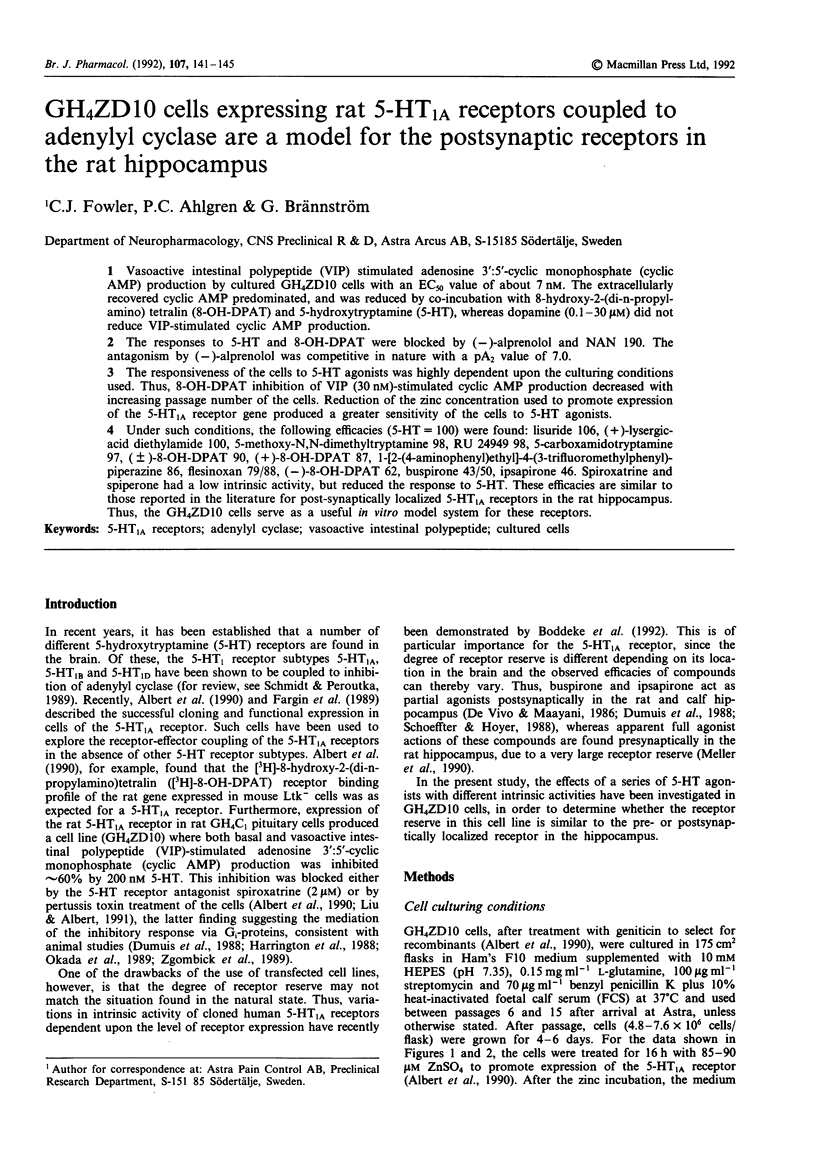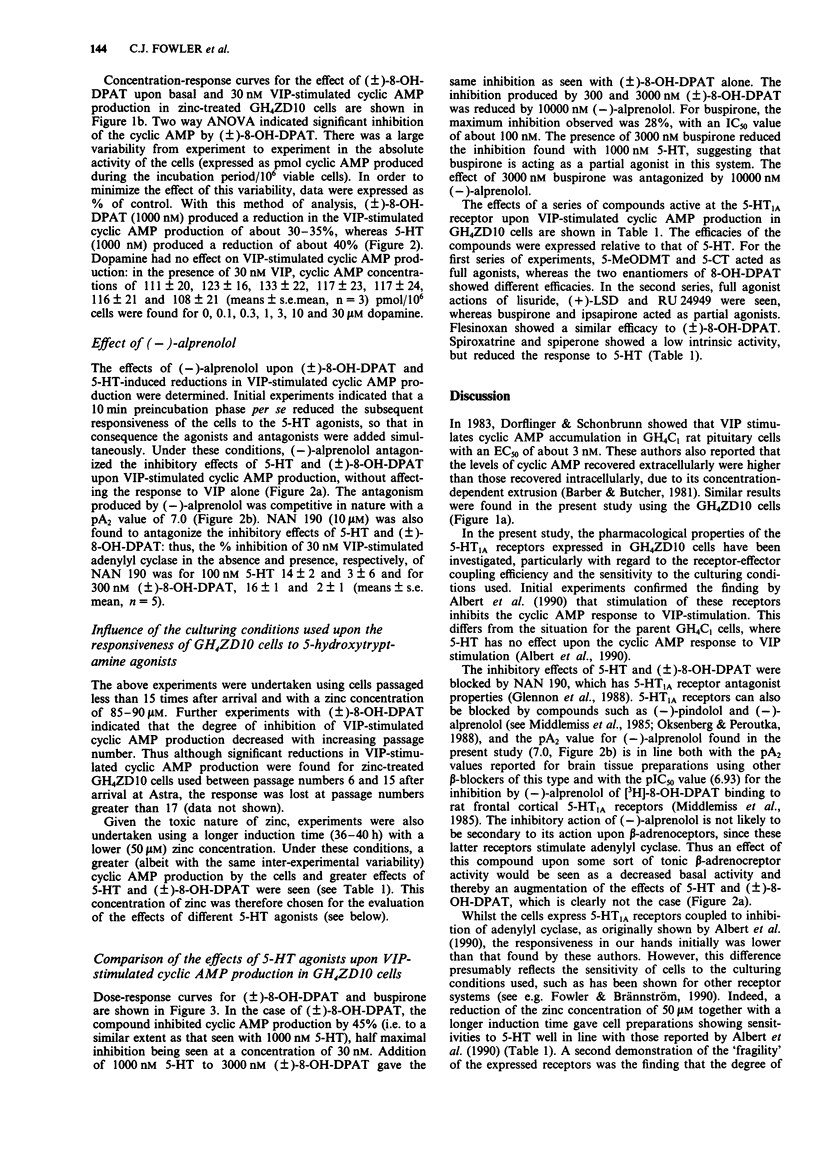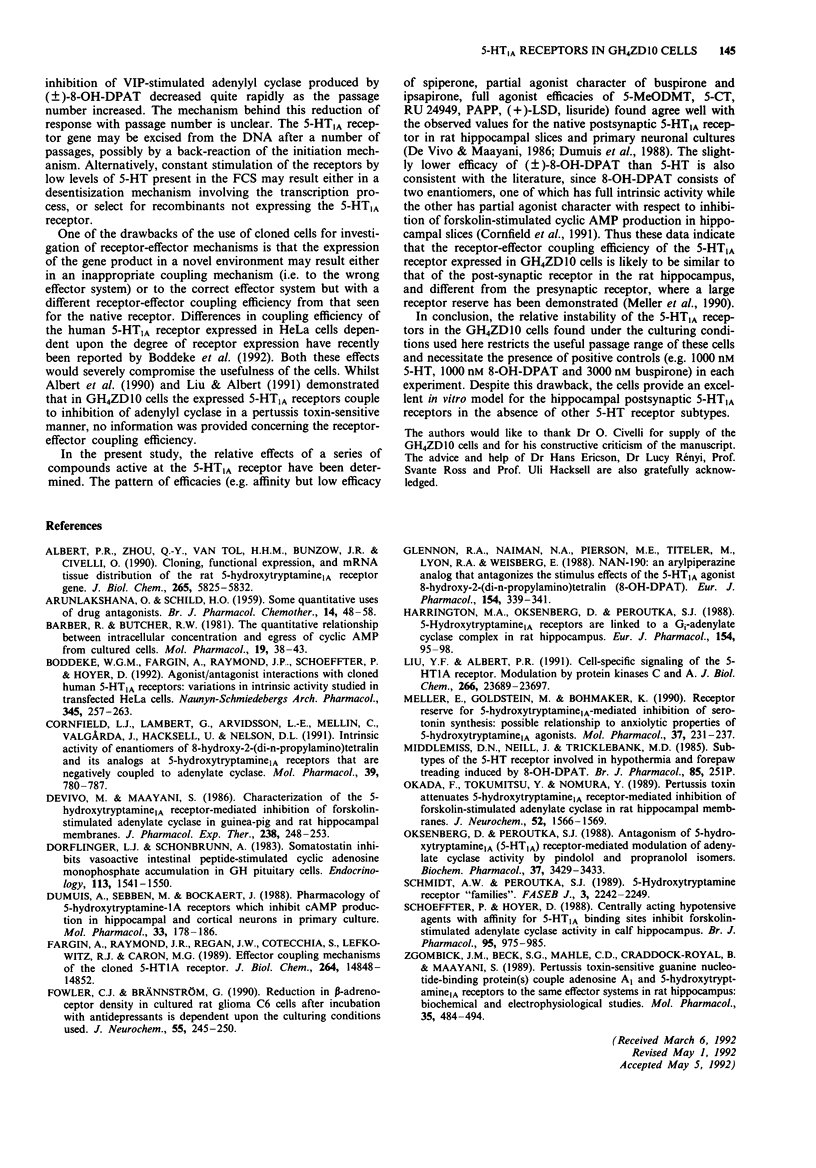Abstract
1. Vasoactive intestinal polypeptide (VIP) stimulated adenosine 3':5'-cyclic monophosphate (cyclic AMP) production by cultured GH4ZD10 cells with an EC50 value of about 7 nM. The extracellularly recovered cyclic AMP predominated, and was reduced by co-incubation with 8-hydroxy-2-(di-n-propyl-amino) tetralin (8-OH-DPAT) and 5-hydroxytryptamine (5-HT), whereas dopamine (0.1-30 microM) did not reduce VIP-stimulated cyclic AMP production. 2. The responses to 5-HT and 8-OH-DPAT were blocked by (-)-alprenolol and NAN 190. The antagonism by (-)-alprenolol was competitive in nature with a pA2 value of 7.0. 3. The responsiveness of the cells to 5-HT agonists was highly dependent upon the culturing conditions used. Thus, 8-OH-DPAT inhibition of VIP (30 nM)-stimulated cyclic AMP production decreased with increasing passage number of the cells. Reduction of the zinc concentration used to promote expression of the 5-HT1A receptor gene produced a greater sensitivity of the cells to 5-HT agonists. 4. Under such conditions, the following efficacies (5-HT = 100) were found: lisuride 106, (+)-lysergic-acid diethylamide 100, 5-methoxy-N,N-dimethyltryptamine 98, RU 24949 98, 5-carboxamidotryptamine 97, (+/-)-8-OH-DPAT 90, (+)-8-OH-DPAT 87, 1-[2-(4-aminophenyl)ethyl]-4-(3-trifluoromethylphenyl)-piperazine 86, flesinoxan 79/88, (-)-8-OH-DPAT 62, buspirone 43/50, ipsapirone 46. Spiroxatrine and spiperone had a low intrinsic activity, but reduced the response to 5-HT. These efficacies are similar to those reported in the literature for post-synaptically localized 5-HT1A receptors in the rat hippocampus.(ABSTRACT TRUNCATED AT 250 WORDS)
Full text
PDF




Selected References
These references are in PubMed. This may not be the complete list of references from this article.
- ARUNLAKSHANA O., SCHILD H. O. Some quantitative uses of drug antagonists. Br J Pharmacol Chemother. 1959 Mar;14(1):48–58. doi: 10.1111/j.1476-5381.1959.tb00928.x. [DOI] [PMC free article] [PubMed] [Google Scholar]
- Albert P. R., Zhou Q. Y., Van Tol H. H., Bunzow J. R., Civelli O. Cloning, functional expression, and mRNA tissue distribution of the rat 5-hydroxytryptamine1A receptor gene. J Biol Chem. 1990 Apr 5;265(10):5825–5832. [PubMed] [Google Scholar]
- Barber R., Butcher R. W. The quantitative relationship between intracellular concentration and egress of cyclic AMP from cultured cells. Mol Pharmacol. 1981 Jan;19(1):38–43. [PubMed] [Google Scholar]
- Boddeke H. W., Fargin A., Raymond J. R., Schoeffter P., Hoyer D. Agonist/antagonist interactions with cloned human 5-HT1A receptors: variations in intrinsic activity studied in transfected HeLa cells. Naunyn Schmiedebergs Arch Pharmacol. 1992 Mar;345(3):257–263. doi: 10.1007/BF00168684. [DOI] [PubMed] [Google Scholar]
- Cornfield L. J., Lambert G., Arvidsson L. E., Mellin C., Vallgårda J., Hacksell U., Nelson D. L. Intrinsic activity of enantiomers of 8-hydroxy-2-(di-n-propylamino)tetralin and its analogs at 5-hydroxytryptamine1A receptors that are negatively coupled to adenylate cyclase. Mol Pharmacol. 1991 Jun;39(6):780–787. [PubMed] [Google Scholar]
- De Vivo M., Maayani S. Characterization of the 5-hydroxytryptamine1a receptor-mediated inhibition of forskolin-stimulated adenylate cyclase activity in guinea pig and rat hippocampal membranes. J Pharmacol Exp Ther. 1986 Jul;238(1):248–253. [PubMed] [Google Scholar]
- Dorflinger L. J., Schonbrunn A. Somatostatin inhibits vasoactive intestinal peptide-stimulated cyclic adenosine monophosphate accumulation in GH pituitary cells. Endocrinology. 1983 Nov;113(5):1541–1550. doi: 10.1210/endo-113-5-1541. [DOI] [PubMed] [Google Scholar]
- Dumuis A., Sebben M., Bockaert J. Pharmacology of 5-hydroxytryptamine-1A receptors which inhibit cAMP production in hippocampal and cortical neurons in primary culture. Mol Pharmacol. 1988 Feb;33(2):178–186. [PubMed] [Google Scholar]
- Fargin A., Raymond J. R., Regan J. W., Cotecchia S., Lefkowitz R. J., Caron M. G. Effector coupling mechanisms of the cloned 5-HT1A receptor. J Biol Chem. 1989 Sep 5;264(25):14848–14852. [PubMed] [Google Scholar]
- Fowler C. J., Brännström G. Reduction in beta-adrenoceptor density in cultured rat glioma C6 cells after incubation with antidepressants is dependent upon the culturing conditions used. J Neurochem. 1990 Jul;55(1):245–250. doi: 10.1111/j.1471-4159.1990.tb08845.x. [DOI] [PubMed] [Google Scholar]
- Glennon R. A., Naiman N. A., Pierson M. E., Titeler M., Lyon R. A., Weisberg E. NAN-190: an arylpiperazine analog that antagonizes the stimulus effects of the 5-HT1A agonist 8-hydroxy-2-(di-n-propylamino)tetralin (8-OH-DPAT). Eur J Pharmacol. 1988 Sep 23;154(3):339–341. doi: 10.1016/0014-2999(88)90212-9. [DOI] [PubMed] [Google Scholar]
- Harrington M. A., Oksenberg D., Peroutka S. J. 5-Hydroxytryptamine1A receptors are linked to a Gi-adenylate cyclase complex in rat hippocampus. Eur J Pharmacol. 1988 Sep 1;154(1):95–98. doi: 10.1016/0014-2999(88)90369-x. [DOI] [PubMed] [Google Scholar]
- Liu Y. F., Albert P. R. Cell-specific signaling of the 5-HT1A receptor. Modulation by protein kinases C and A. J Biol Chem. 1991 Dec 15;266(35):23689–23697. [PubMed] [Google Scholar]
- Meller E., Goldstein M., Bohmaker K. Receptor reserve for 5-hydroxytryptamine1A-mediated inhibition of serotonin synthesis: possible relationship to anxiolytic properties of 5-hydroxytryptamine1A agonists. Mol Pharmacol. 1990 Feb;37(2):231–237. [PubMed] [Google Scholar]
- Okada F., Tokumitsu Y., Nomura Y. Pertussis toxin attenuates 5-hydroxytryptamine1A receptor-mediated inhibition of forskolin-stimulated adenylate cyclase activity in rat hippocampal membranes. J Neurochem. 1989 May;52(5):1566–1569. doi: 10.1111/j.1471-4159.1989.tb09209.x. [DOI] [PubMed] [Google Scholar]
- Oksenberg D., Peroutka S. J. Antagonism of 5-hydroxytryptamine1A (5-HT1A) receptor-mediated modulation of adenylate cyclase activity by pindolol and propranolol isomers. Biochem Pharmacol. 1988 Sep 15;37(18):3429–3433. doi: 10.1016/0006-2952(88)90692-2. [DOI] [PubMed] [Google Scholar]
- Schmidt A. W., Peroutka S. J. 5-Hydroxytryptamine receptor "families". FASEB J. 1989 Sep;3(11):2242–2249. doi: 10.1096/fasebj.3.11.2673898. [DOI] [PubMed] [Google Scholar]
- Schoeffter P., Hoyer D. Centrally acting hypotensive agents with affinity for 5-HT1A binding sites inhibit forskolin-stimulated adenylate cyclase activity in calf hippocampus. Br J Pharmacol. 1988 Nov;95(3):975–985. doi: 10.1111/j.1476-5381.1988.tb11728.x. [DOI] [PMC free article] [PubMed] [Google Scholar]
- Zgombick J. M., Beck S. G., Mahle C. D., Craddock-Royal B., Maayani S. Pertussis toxin-sensitive guanine nucleotide-binding protein(S) couple adenosine A1 and 5-hydroxytryptamine1A receptors to the same effector systems in rat hippocampus: biochemical and electrophysiological studies. Mol Pharmacol. 1989 Apr;35(4):484–494. [PubMed] [Google Scholar]


